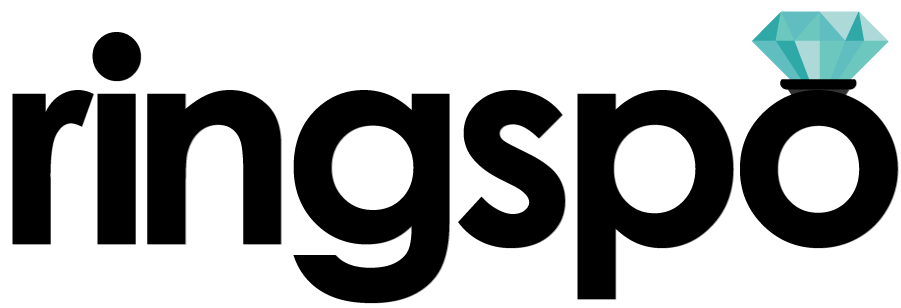Diamond Carat
It’s a weighty issue
Ringspo is reader supported
Ringspo is reader-supported, which means we may receive a commission if you click a link to a retailer & subsequently make a purchase.
We feature links to several retailers to help readers find the one that is the best fit for them. Find out more about how Ringspo works here.
When recently engaged women talk about and compare engagement rings, they don’t talk about the level of cut, color or clarity of their rings, even if their diamonds score extremely highly in these characteristics. Instead, rightly or wrongly, there’s just one characteristic of the ring that is asked about and compared – the diamond carat weight.
So, the bigger the better, right? You should go as big as you can?
Not necessarily. Read on to find out more.
So what are carats?
Carats are a measure of the weight of a diamond, rather than its size.
This might seem like a weird distinction to make, but two diamonds with the same carat weight can be cut to have different physical dimensions, like the two below.

These two stones would look very different sizes one placed in a ring setting – the stone on the right is wider so would look much larger. More importantly though, the two stones would refract and reflect light in different ways and sparkle different amounts.
As it’s a measure of weight, you might be wondering why we don’t just use ounces or grammes to measure?
Here’s a very quick history lesson for you. The word carat actually comes from ‘carob’, which is a tree found around the Mediteranean and the Middle East. In days of yore seeds from the carob tree were used to weigh diamonds – one carob pod was the equivalent of one carat of diamond.

But as carob pods are naturally occurring, there’s some variety in their size and weight, so in 1907 the weight for one carat was standardised. It was defined as 200mg, or 1/5 of a gram (0.007 ounce), which is the size we still use today.
One thing to watch out for is that precious stone carats and gold karats are completely unrelated.
Carat weight and visible size
As carat is a measure of weight and not the physical size of a stone, its relationship to how big a rock actually looks is a complicated one. And, as we’ll see, a physically larger diamond doesn’t necessarily mean that it’s more impressive.
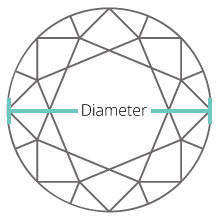
The table below shows the diameter of round brilliant stones at a range of carat sizes.
The diameters given are for stones that have an ‘excellent’ cut, so the proportions of them have been optimised for the best possible sparkle.
| Carat weight | Width (mm) |
|---|---|
| 0.40cts | 4.7mm |
| 0.50cts | 5.0mm |
| 0.60cts | 5.5mm |
| 0.70cts | 5.7mm |
| 0.80cts | 6.0mm |
| 0.90cts | 6.2mm |
| 1.00cts | 6.5mm |
| 1.25cts | 7.0mm |
| 1.50cts | 7.5mm |
| 2.00cts | 8.0mm |
As you look down the table, you can see that doubling the carat weight of a diamond definitely doesn’t double the visible dimeter of the stone, which is the size that is most noticeable once a diamond is in an engagement ring setting.
Doubling the weight from 0.5 carats to 1 carat gives just a 1.5mm increase in size – 25%.
Doubling that to 2 carats (which would result in a huge increase in price, as we’ll see in the next section) results in another 1.5mm increase in size, although the step up percentage-wise is slightly less than 25% this time.
Looking at both those increases together and quadrupling the carat weight from 0.5 carats to 2 carats gives an increase from 5.0mm (0.195 inches) to 8.0mm (0.314 inches). So, despite increasing the carat weight by 400%, and the price by much more than that as we’ll see in the next section, the diameter and ‘face up’ size of the stone only increases by 60%.
The tool below from the Gemological Institute of America (GIA) is a good way to compare different sizes visually.
Why there are such small jumps in visible size when the carat weight increases
As you are moving the slider above, you might notice that if you go from say 0.9 carats to 1 carat, the size of the stone doesn’t actually seem to increase much.
This is because the size of the stone is actually proportional to the increase in weight, but the measurements in the table only show the ‘face up’ diameter. This is the most visible measurement of physical size, but as diamonds are 3D, it’s only one measurement of size.
The image below shows a 0.5 carat (black) and a 1 carat diamond (green) to scale.
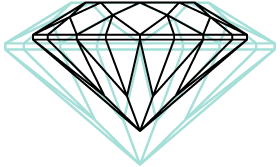
You can see that as the weight increases, so too does the depth of the diamond, and the volume. Much of the increase in weight is hidden in the bottom half of the diamond, which will be invisible once it is set in a ring setting.
It’s important that the diamond is still cut to these proportions, instead of wider and less deep which would give a larger visible diameter, to ensure that the diamond sparkles well and isn’t dull and lifeless.
The next imge shows the difference between a 0.8 carat diamond and a 1 carat stone.

The difference in width between the two is very small indeed, which means that they’ll look very similar once they are mounted in a ring.
Diamond carat weight and price
Diamond carat weight is the single biggest factor affecting how much you’ll pay for a stone. It’s the easiest factor for us to get our head around and the easiest way for us to compare different stones. Guys are used to comparing things using numbers, from how much they can bench press to the displacement of their car’s engine.
Larger diamonds are rarer. It’s less common to find larger rough diamonds in mines, and much less common to find high quality rough diamonds. As with everything, the rarer something is, the more expensive it is. Basic economics 101. So as you increase the size of the stone, not only does the cost increase, but so too does the cost per carat.
So, if a one carat diamond for given quality is $7,000 per carat, a one carat stone would therefore be $7,000. But a two carat diamond of the same quality would be much less common, so the price per carat will by much higher than for the one carat stone. stone
To show how size can affect price, I conducted an experiment using one of my recommended retailers. I looked at a stone with identical specs in all of the other Cs, and just changed the carat weight. I looked at a round brilliant stone, with the following specs:
- Clarity: VS1
- Color: G
- Cut: Excellent
Here’s how the price changed at different carat weights:
| Carat weight | Width (mm) | Price (USD) |
|---|---|---|
| 0.40cts | 4.7mm | $843 |
| 0.50cts | 5.0mm | $1,505 |
| 0.60cts | 5.5mm | $1,826 |
| 0.70cts | 5.7mm | $2,652 |
| 0.80cts | 6.0mm | $3,632 |
| 0.90cts | 6.2mm | $4,468 |
| 1.00cts | 6.5mm | $6,096 |
| 1.25cts | 7.0mm | $9,098 |
| 1.50cts | 7.5mm | $11,511 |
| 2.00cts | 8.0mm | $19,942 |
Looking at the table, you can see that there are some pretty big difference. Increasing the size from 0.8 carat to 1 carat will give an increase in diameter from 6.0mm to 6.5mm (a difference of 17%), but the price will increase by 67%.
As you go larger, the stones get more rare, so more expensive and the difference is even greater. Increasing size from 1 carat to 1.5 carat will result in a 1mm increase in diameter (15%) on the visible width, but an 88% increase in price – almost double.
Magic Weights
Jewelers know that certain weights are benchmarks for people. People like to say they have a ‘1 carat’ ring, for example, or 0.9, or 0.75 These nice round numbers are called ‘magic weights’ in the jewelry industry.
So, if a jeweler has a choice of cutting a rough stone into a 0.98 carat stone with ideal proportions, or fudging a 1 carat ring with less perfect proportions, they will often cut the stone to make sure that it hits the magic 1 carat mark, despite the fact that the difference in visible size would be nearly impossible to distinguish.
But no-one is ever going to know if your rock is 0.95 carats or 1.02. In the real world the difference is basically theoretical. But they will notice if your stone doesn’t sparkle and looks lifeless because it has been cut to less than ideal proportions.
When searching for diamonds, it’s always worth looking for a stone that is just below a round numbered ‘magic weight’ as it can offer significant savings with no noticeable decrease in visible size.
Diamonds cut for carat weight
Because jewelers know that size is the first thing that people are likely to look at when comparing a diamond, they try to maximize the size of diamond that they get from a rough stone, even at the expense of other attributes that can actually contribute more to the impressiveness of a ring.
For example, the rough stone below could either be cut to provide two diamonds that weigh 3 carats between them that have a ‘fair’ cut grade and sell for a total of $35,000, or could be cut to produce two round brilliant diamonds that weigh 2.2 carats with excellent cut grade which are only worth $20,000.
3 carats of poorly cut diamond, with minimum wastage:

2.2 carats of ideal cut diamond, with much more wastage:

This is definitely understandable from the jewelers’ point of view – they cater to people’s obsession with diamond size, and ignorance of the importance of diamond cut, to maximise their profit.
But, if you don’t want to get stuck with one of the larger but poorly cut diamonds that just don’t sparkle, always make sure you go for the highest cut grade you can. It’s the cut quality and the proportions play the biggest part in how much light is reflected back to your eye, how much the diamond sparkles and really how impressive it is.
Total Carat Weight
If you know that you definitely want to reach a certain carat weight, but your budget doesn’t quite stretch to a 1.5 carat center stone, then there is something that you can do to ensure that the diamond weight in your ring does hit a particular magic mark.
Total carat weight is found by adding up the carats of all of the stones in a ring.
If you go for a single stone solitaire setting, then the center stone is left out there flapping in the wind on its own, with nothing to help it. It has to do all the impressing on its own. It’s got no wingmen.
Adding sidestones to a stone or a halo setting will add up to a significant total carat weight without the big increase in cost that increasing the center stone by the same amount would.
These do make the setting more expensive, but they will mean that you can go for a smaller center stone without losing any impressiveness, so the net impact on price should be lower.

Platinum halo setting with 0.25ct diamonds – $1,850
0.75 carat round briliant diamond, color G, clarity VS1 – $2,952
Total price for 1 carat TCW = $4,802

Platinum solitaire setting – $740
1 carat round brilliant diamond, color G, clarity VS1 – $6,096
Total price for 1 carat TCW = $6,836
Watch out: CTW
The other side of this is of course that you need to be careful if you are looking at a ring and someone quotes you the Total Carat Weight (or if you see CTW written down).
Ensure that center stone weight is quoted separately as well and that this is a reasonable price. If you’re looking in a bricks and mortar store then compare the center stone price to an equivalent stone using one of my recommended retailers to ensure that it is a fair price.
Watch out 2: ‘Light’ carat weights
Some jewelers will round a stone up to the nearest round number when talking about a stone. A stone that is 0.46 carats may be talked about as a ‘half carat stone’. Surprisingly, this is totally legal in the US, but what it means is that you need to make sure that before you actually spend any money or put a deposit down you see the certification which lists the stone’s exact weight. If the jeweler isn’t willing to show it to you then they may have something to hide.
An easy way to increase carat weight
If carat weight is important to you, there’s another great way to make sure you hit a magic weight, without sacrificing the color, clarity or cut of the stone, but still making considerable savings.
That’s by choosing a stone shape other than a round brilliant diamond. Round brilliants are the most common, but also by fair the most expensive stone shape. Choosing another shape can give you a ring that is no less impressive, but much less expensive:


How big should you go?
Wedding website The Knot polled 5,638 people to find the carat size for their engagement ring, and the results came back as follows:
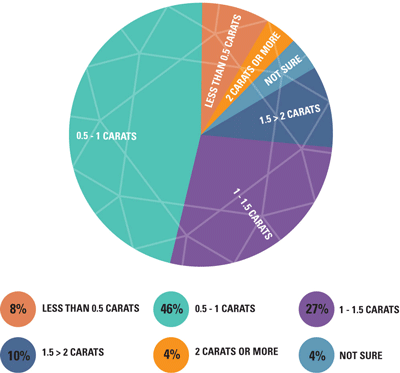
You can see that a big proportion of rings – over half – are under 1 carat. And the second biggest chunk are just over the magic weight of 1 carat. With 27% of people going for a stone between 1 and 1.15, this shows how important the psychological boundary of 1 carat is.
But no-one is ever going to know if your rock is 0.95 carats or 1.02. In the real world the difference is basically theoretical. But they will notice if your stone doesn’t sparkle and looks lifeless.
Hopefully in this post you’ve learnt that size isn’t everything, and blindly going for the biggest stone that you can afford, or going for a magic weight like 1 carat just because you think you should isn’t the way to go. Really, carat weights are arbitrary, and although it’s nice to hit a nice round ‘magic’ weight, it won’t have any effect on how big the stone looks or how impressive it is.
However, there’s no doubt that carat ‘size’ is the thing that people often ask about. I always always always recommend prioritising cut over size, as it’s the biggest factor in how much light a diamond returns to your eyes, how much it sparkles and how impressive the ring is.
But, if you do want to maximise your size within your budget then by being smart about avoiding magic weights, going a shape other than round brilliant and choosing your setting carefully, you can get an awesome ring without getting stung by the size.
Learn about the rest of the 4Cs
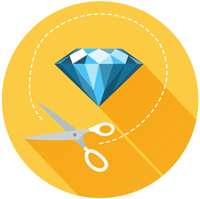
Cut
The most important ‘C’
of all

Clarity
How to avoid paying over the odds

Color
Make sure it makes a difference
